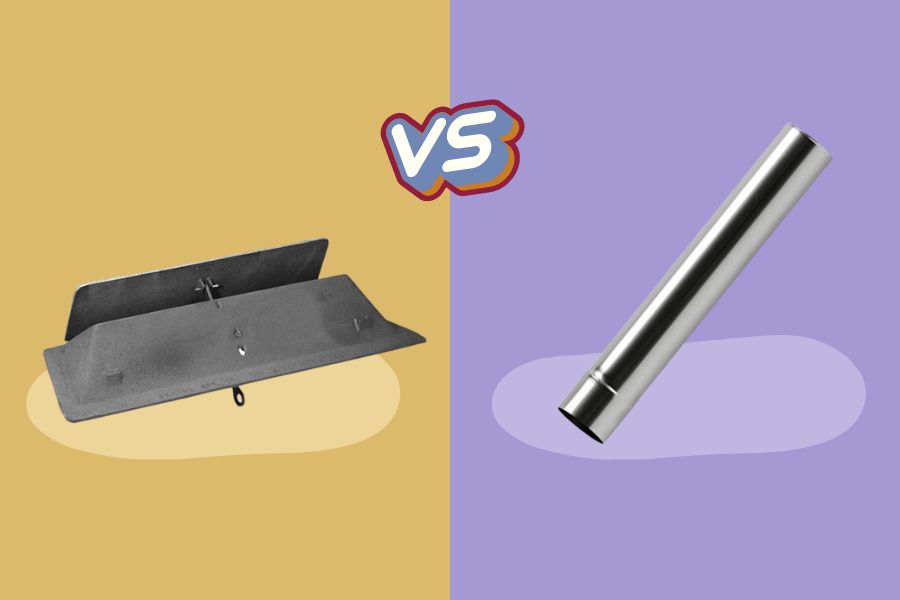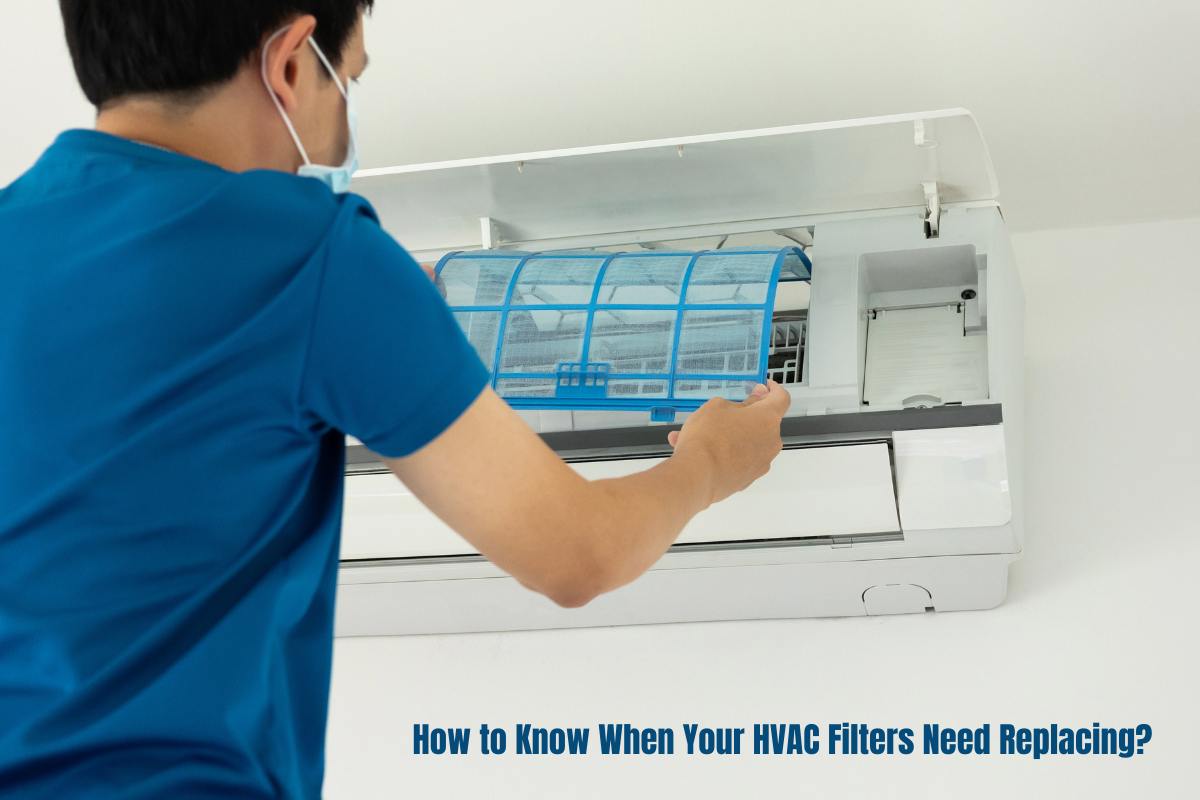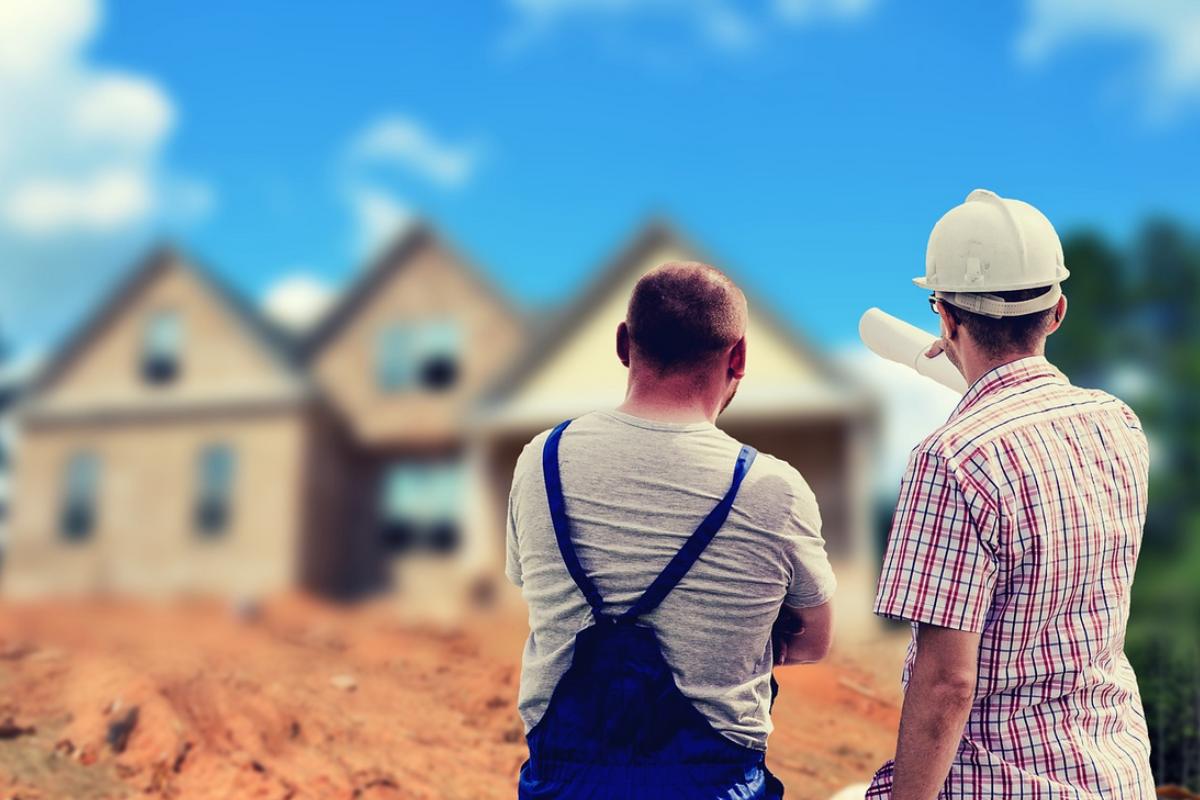If you’re a homeowner with a wood burning stove or fireplace, you may have come across the terms “damper” and “flue” when discussing your chimney’s functionality. While both play crucial roles in ensuring your fireplace’s safe and efficient operation, they serve different purposes.
This article will delve into the key distinctions between dampers and flues, their significance, and how they impact your chimney’s performance.
What’s the Difference Between a Flue and a Damper?
Let’s start by clarifying the primary differences between these two essential components of your chimney system. Many people often confuse flues with dampers, but they serve distinct functions.
Is There A Difference Between Dampers And Flues?
The short answer is yes, there is indeed a difference between dampers and flues. To put it simply, a fireplace flue is a duct or passageway that allows smoke, gases, and combustion byproducts to exit your home safely.
It acts as a conduit, ensuring proper ventilation and preventing harmful, toxic gases, from seeping back into your living space.
On the other hand, a fireplace damper is a movable plate, pipe, or valve located within the flue. Its primary role is to fire the system, control the airflow, and regulate the amount of heat escaping through the chimney.
What Is a Fireplace Flue?
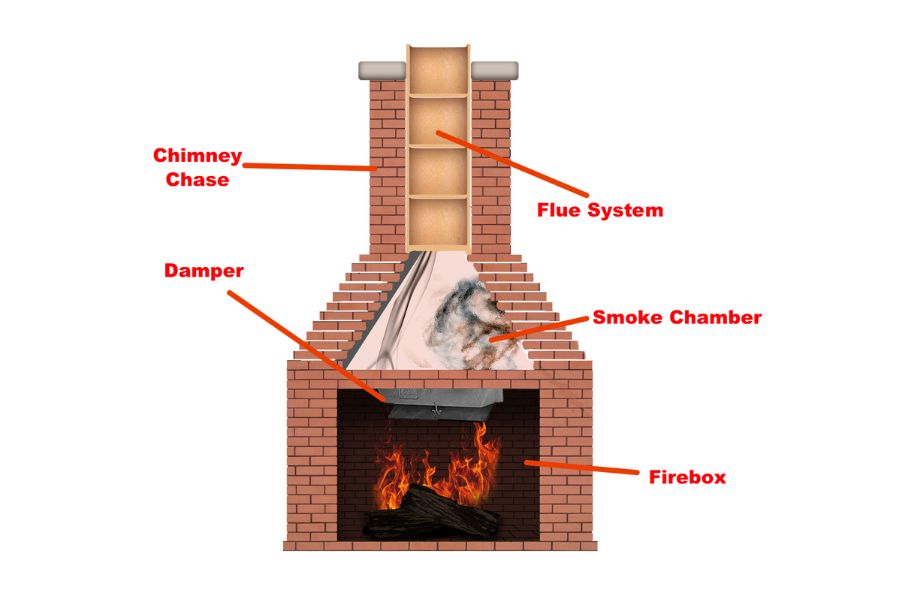
The fireplace flue is a critical component of your chimney system, responsible for guiding smoke and gases away from your home.
As you ignite a fire in your wood-burning fireplace, smoke and other byproducts are produced by broken flue. Without a properly functioning flue, these hazardous substances would linger inside your home, posing health risks and causing discomfort.
The flue is a simple pipe usually constructed as a vertical passage that runs through the center of your chimney.
Its interior is smooth to allow for smooth airflow, and it is typically made of brick, clay tiles, or metal, depending on the type of fireplace and local building codes.
How Does a Fireplace Flue Work?
Understanding how a fireplace flue operates is essential to grasp its significance. Flues come in various shapes and sizes, depending on the type of fireplace and the fuel used.
For example, wood-burning fireplaces usually have larger flues than gas fireplaces due to the difference in combustion byproducts and combustion gases. The size of the fire in the fireplace and flue also affects the fireplace’s efficiency and how well it can draw smoke out of the house.
Types of Fireplace Flue
Before we delve deeper, let’s explore the different types of fireplace flues commonly found in homes:
- Traditional Masonry Flue: This type of flue is built with bricks or clay tiles and is commonly found in older homes. While durable, they can be prone to cracks and damage over time.
- Metal Flue: These are pre-fabricated flue liners of stainless steel or other metals. They are often used in modern homes and provide excellent insulation and durability.
- Cast-in-Place Flue: This type of flue is created by pouring a special cement mixture directly into the chimney. It offers a smooth and seamless finish but may require professional installation.
How to Tell if the Fireplace Damper Is Open or Closed
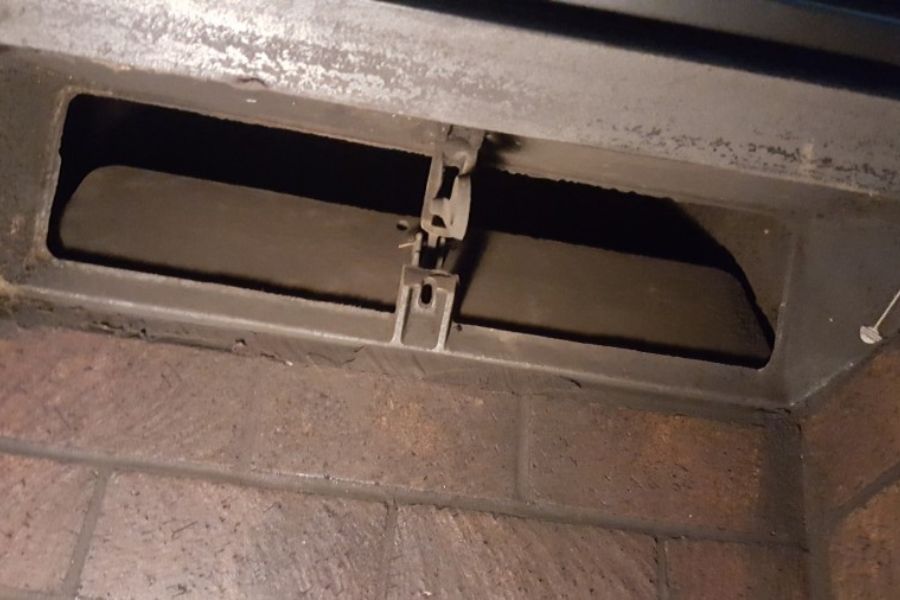
Now that we’ve covered the basics of flues, let’s shift our focus to fireplace dampers. The damper’s position can significantly impact your fireplace’s efficiency and energy consumption.
If you’re unsure whether your damper is fully open, or closed, here are some tips to help you determine its position.
How to Open and Close Your Chimney Damper
Most fireplace dampers have a lever or handle that allows you to open and close them. When the damper opens, the air can flow freely through the chimney, promoting a steady draft and efficient burning.
However, if the damper is closed, it prevents warm air from escaping, which can help retain heat within your living space when the fireplace is not in use.
It’s essential to check the damper’s position before starting a fire to avoid smoke filling your home.
Do All Fireplaces Have a Damper?
While many modern fireplaces are equipped with dampers, not all of them have this feature. Older fireplaces, especially those in historic homes, may lack dampers or have non-functional ones.
If you have an older fireplace without a damper, it’s worth considering installing one to enhance safety and energy efficiency.
Rusted or Broken Damper
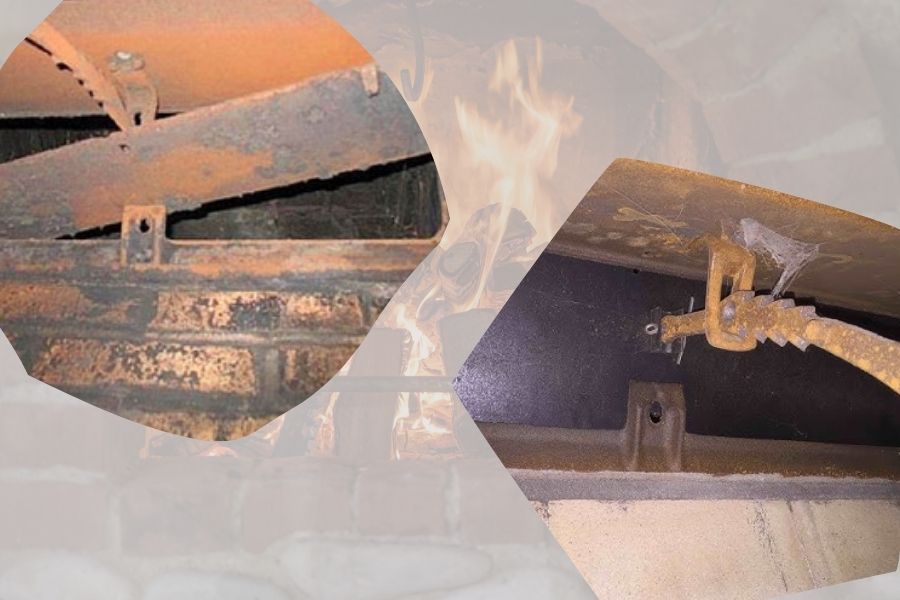
Over time, wear and tear can affect fireplace dampers, particularly when they are exposed to harsh weather conditions or excessive moisture.
One common issue involves dampers becoming rusted or broken. Rust or corrosion can cause dampers to become stuck in a particular position, making it challenging to open or close them effectively.
A broken damper can also cause issues, as it may not function as intended, leading to heat loss or difficulty controlling airflow. If you notice any signs of rust, corrosion, or damage, it’s crucial to address the issue promptly.
A malfunctioning damper can not only compromise the efficiency of your fireplace but also pose safety risks.
Chimney Flue Obstructions
In addition to damper issues, flue obstructions can also arise with your chimney flue system.
Flue obstructions can occur for various reasons, including debris buildup, bird nests, or creosote. These obstructions can restrict the smooth flow of smoke and gases, preventing warm air and leading to a drafty or smoky fireplace. In severe cases, they can even pose a fire hazard.
Regular chimney flue maintenance, including chimney damper cleaning and inspections, can help detect and address flue obstructions before they cause significant problems. Hiring a professional chimney sweeper is recommended to ensure a thorough cleaning and proper removal of any blockages.
Creosote in the Flue
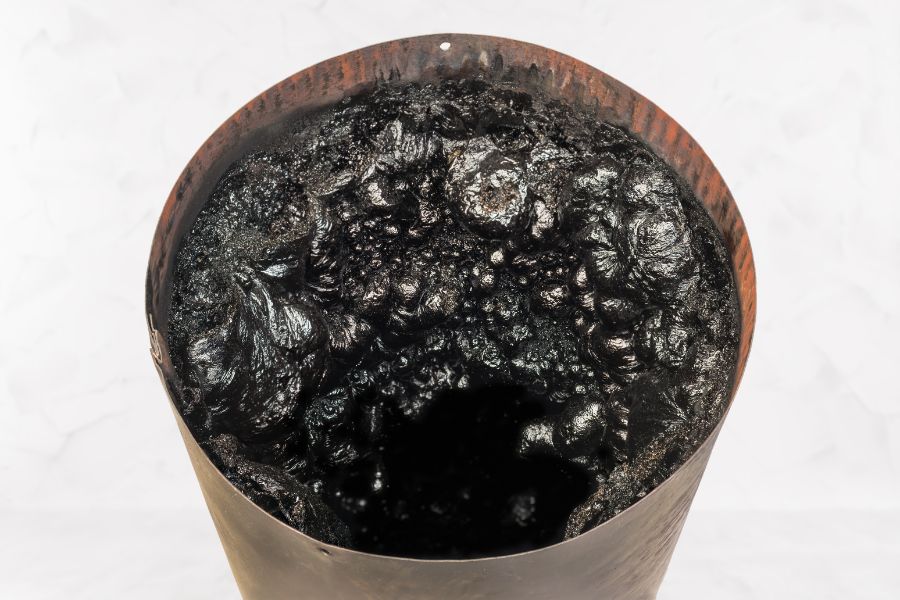
Creosote is a natural byproduct of wood-burning fires, and it can accumulate inside your flue over time. It is highly flammable, and if it builds up in significant amounts, it can lead to chimney fires.
Therefore, annual chimney cleaning is essential to remove creosote buildup and reduce the risk of chimney fires.
A professional chimney sweep will inspect your flue and chimney liners, and safely and effectively remove any creosote deposits. Burning seasoned wood and maintaining proper airflow in your fireplace can help minimize creosote buildup.
The Significance of a Chimney Cap
A chimney cap is a protective covering on top of the flue. It plays a vital role in safeguarding your chimney system and complements the functionality of both the damper and the flue opening.
- Protection against Debris and Animals: Chimney caps keep debris, leaves, twigs, and animals from entering the chimney, preventing blockages and most chimney fires.
- Compatibility with Damper and Flue Types: Chimney caps come in various designs to suit different dampers and flues, ensuring seamless compatibility with your chimney system.
- Enhancing Overall Chimney Performance: By preventing rainwater, snow, and debris from entering the flue, a chimney cap helps maintain the chimney lining’s integrity and prevents water-related damage.
Investing in a high-quality chimney cap ensures the optimal performance and longevity of your fireplace and chimney, keeping your home safe, comfortable, and enjoyable year after year. Include a chimney cap as part of your regular chimney maintenance and inspections for the best results.
Chimney Damper Maintenance Cost
Proper chimney damper maintenance is essential to ensure your wood-burning stoves’ longevity and efficiency. The cost of maintaining a proper fireplace and damper can vary depending on the type of damper you have and the extent of the maintenance required.
Routine maintenance tasks may include cleaning the damper, inspecting for any damages, and lubricating moving parts to ensure smooth operation.
For simple maintenance tasks, such as cleaning and lubricating, you can do it yourself with some basic tools and supplies.
However, it’s best to seek professional assistance from a qualified chimney technician for more complex issues, such as repairing a broken damper.
Your Fireplace Damper
Your fireplace damper plays a crucial role in controlling your home’s airflow and heat loss. As mentioned earlier, keeping the damper in good working condition is essential for optimal fireplace performance and energy efficiency.
Regular inspection and maintenance of the damper will ensure it operates smoothly and prevent any cold air from leaking when the fireplace is not in use.
If you notice any issues with your damper, such as difficulty in opening or closing, rust, or damage, it’s essential to address them promptly. Neglecting damper issues can lead to heat loss, decreased energy efficiency, and potential safety hazards.
What Size Fireplace Damper Do I Need?
The size of your fireplace damper is an essential factor that determines its effectiveness. A damper that is too small may restrict airflow and cause smoke to back up into your home, while a damper that is too large may result in excessive heat loss when the fireplace is not in use.
To determine the correct size for your fireplace damper, it’s best to consult with a professional chimney technician. They will assess your fireplace and chimney dimensions and recommend the appropriate damper size for optimal firebox performance.
Types of Fireplace Dampers
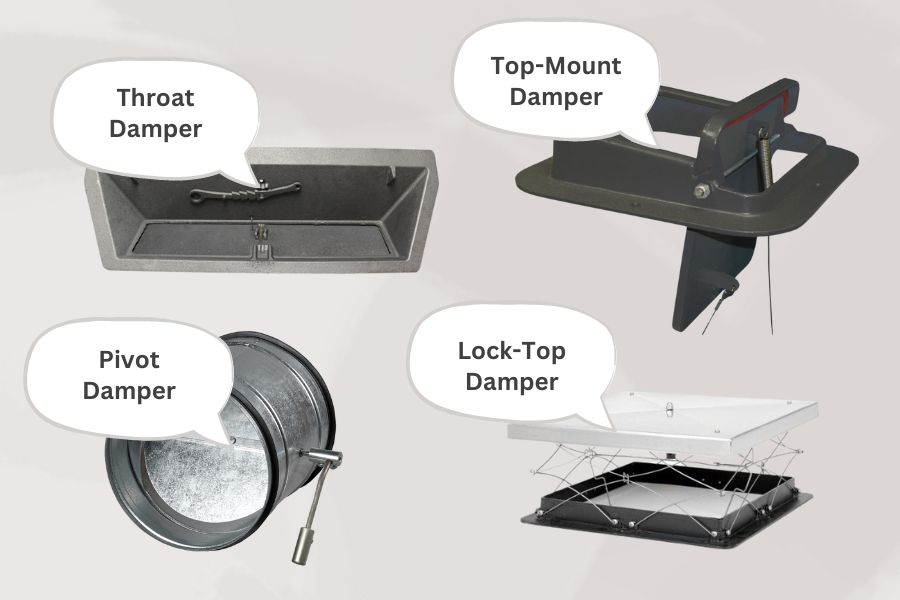
Just as there are different types of flues, various fireplace damper types are available to suit different fireplace designs and fuel types. Here are some common types of fireplace dampers:
- Throat Dampers: Throat dampers are the most common type and are located just above the firebox. They have a hinged metal plate that can be opened or closed by a lever or handle.
- Top-Mount Dampers: Top-mount dampers are installed at the top of the flue and seal the entire chimney when closed. They offer better insulation and prevent outside elements from entering the chimney.
- Pivot Dampers: Pivot dampers swing open and closed on a pivot point. They are less common but can be found in some older fireplace designs.
- Lock-Top Dampers: Lock-top dampers combine a traditional throat damper with a top-sealing cap. They offer improved energy efficiency and protection against moisture and debris.
Each type of damper has its advantages and disadvantages, and the best choice for your fireplace depends on various factors, including the type of fireplace you have and your specific needs.
Conclusion
In conclusion, understanding the differences between dampers and flues is essential for a safe and efficient fireplace.
Regular maintenance, including annual chimney cleaning, ensures optimal performance and reduces the risk of hazards like creosote buildup and flue obstructions.
Consulting a professional for damper sizing and addressing issues promptly guarantees a cozy and secure fireplace experience all year round.
Prioritize safety and invest in regular chimney maintenance for lasting comfort and peace of mind.

